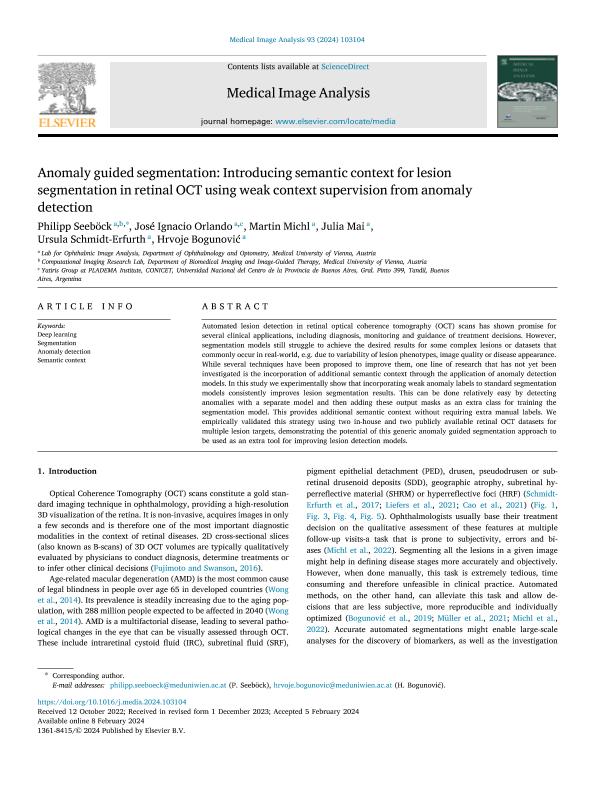Artículo
Anomaly guided segmentation: Introducing semantic context for lesion segmentation in retinal OCT using weak context supervision from anomaly detection
Seeböck, Philipp; Orlando, José Ignacio ; Michl, Martin; Mai, Julia; Schmidt Erfurth, Ursula; Bogunovic, Hrvoje
; Michl, Martin; Mai, Julia; Schmidt Erfurth, Ursula; Bogunovic, Hrvoje
 ; Michl, Martin; Mai, Julia; Schmidt Erfurth, Ursula; Bogunovic, Hrvoje
; Michl, Martin; Mai, Julia; Schmidt Erfurth, Ursula; Bogunovic, Hrvoje
Fecha de publicación:
04/2024
Editorial:
Elsevier Science
Revista:
Medical Image Analysis
ISSN:
1361-8415
e-ISSN:
1361-8423
Idioma:
Inglés
Tipo de recurso:
Artículo publicado
Clasificación temática:
Resumen
Automated lesion detection in retinal optical coherence tomography (OCT) scans has shown promise for several clinical applications, including diagnosis, monitoring and guidance of treatment decisions. However, segmentation models still struggle to achieve the desired results for some complex lesions or datasets that commonly occur in real-world, e.g. due to variability of lesion phenotypes, image quality or disease appearance. While several techniques have been proposed to improve them, one line of research that has not yet been investigated is the incorporation of additional semantic context through the application of anomaly detection models. In this study we experimentally show that incorporating weak anomaly labels to standard segmentation models consistently improves lesion segmentation results. This can be done relatively easy by detecting anomalies with a separate model and then adding these output masks as an extra class for training the segmentation model. This provides additional semantic context without requiring extra manual labels. We empirically validated this strategy using two in-house and two publicly available retinal OCT datasets for multiple lesion targets, demonstrating the potential of this generic anomaly guided segmentation approach to be used as an extra tool for improving lesion detection models.
Palabras clave:
deep learning
,
segmetnation
,
anomaly detection
,
semantic context
Archivos asociados
Licencia
Identificadores
Colecciones
Articulos(CCT - TANDIL)
Articulos de CTRO CIENTIFICO TECNOLOGICO CONICET - TANDIL
Articulos de CTRO CIENTIFICO TECNOLOGICO CONICET - TANDIL
Citación
Seeböck, Philipp; Orlando, José Ignacio; Michl, Martin; Mai, Julia; Schmidt Erfurth, Ursula; et al.; Anomaly guided segmentation: Introducing semantic context for lesion segmentation in retinal OCT using weak context supervision from anomaly detection; Elsevier Science; Medical Image Analysis; 93; 4-2024; 1-15
Compartir
Altmétricas



